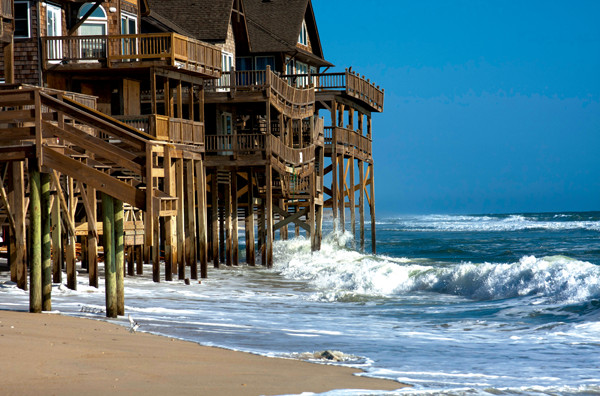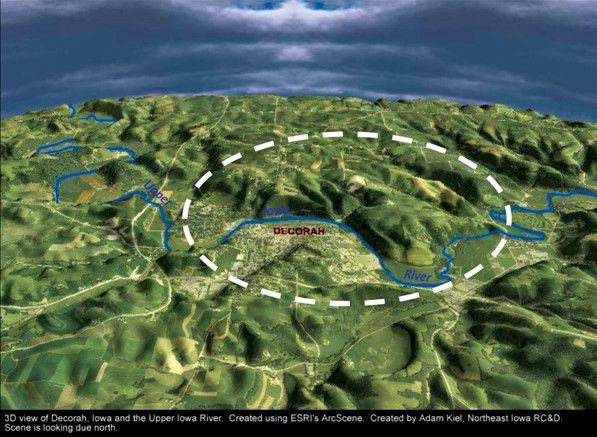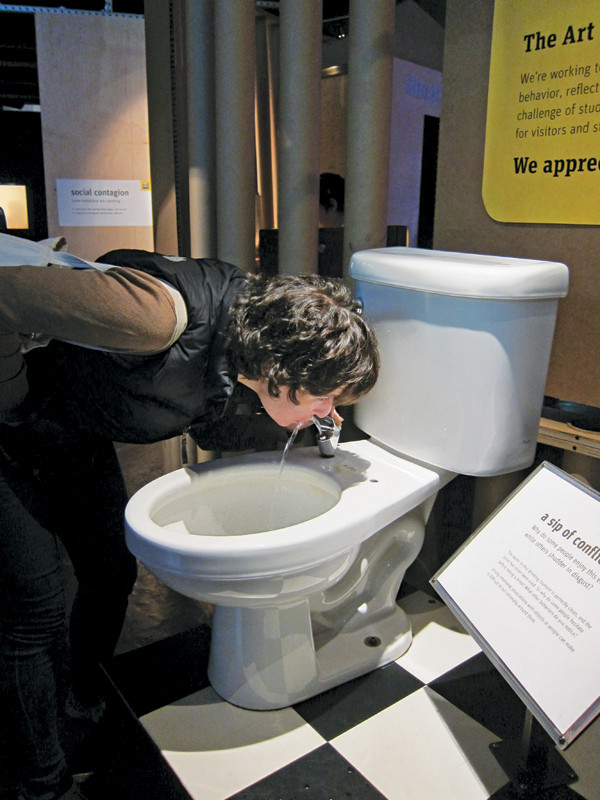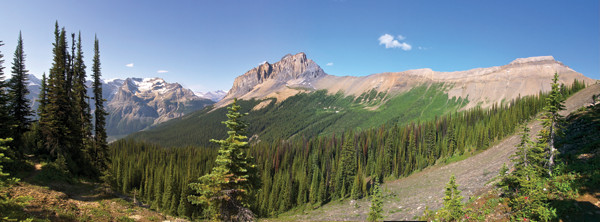
by Timothy Oleson Tuesday, December 31, 2013

Beachfront homes in Rodanthe that will soon fall into the ocean. This row of homes used to include one made famous in the movie "Nights in Rodanthe," but that house was moved to a safer location. Tim Burkitt, FEMA

An airborne geophysical survey has confirmed the discovery of an impact crater under the town of Decorah in northeastern Iowa. Adam Kiel, U.S. Geological Survey

Would you drink water out of a toilet, even if the toilet was never used? That's the question asked at this display at the Exploratorium in San Francisco, Calif. It's also a question on the minds of those working on wastewater recycling plans. Kathleen Canter, with permission of the Exploratorium

The Burgess Shale's Walcott and Raymond quarries lie on the ridge between Mount Wapta (left) and Mount Field (right), across from Burgess Mountain in Canada's Yoho National Park. Mary Caperton Morton
I have been resisting the urge to pull together a “year-in-review” list, mostly because there are already so many out there. (What it is about lists exactly — numbered, bullet-pointed or otherwise — that makes them so attractive remains a mystery, but I confess that whatever their appeal is, it works on me too.) But although there have been a lot of year-in-review and “best of 2013” lists posted, many of which have rehashed and/or ranked science stories from the past year, there haven’t been many focusing specifically on the geosciences. What an oversight, right?!
With all that said, here it is Dec. 31, 2013, and I simply can’t resist the urge to whip up a year-end list any longer. Rather than create my own list, however, I thought I’d see what you, our readers, thought were the most interesting stories — as judged by the number of page visits accrued — posted at EARTH online in 2013.
I and the rest of EARTH’s staff hope you enjoy this quick look back at some of our popular pieces from the past year, and we hope you keep coming back to see the fascinating science in store for 2014. And don’t forget to subscribe to EARTH in print and follow us on Twitter and Facebook. (Lastly, if you’re sick of reading 2013-in-review posts, please forgive me for adding yet another one to the pile. As the tangle of Post-it notes on my desk attests, I clearly succumbed to the lure of lists long ago.)
As 2012’s Superstorm Sandy bore down on the Northeast, storm watchers could tell it would be worse than anything seen in decades, but the storm warnings were missed by many. One disconnect came from strict protocols about how federal agencies issue warnings. Since the devastating storm, federal officials have been revising their protocols to avoid a repeat situation. Will it be enough?
Of all the famous fossil localities in the world, peburrhaps none is as widely celebrated as British Columbia’s Burgess Shale. High in the Canadian Rockies, the Burgess Shale contains some of the oldest and most exquisitely detailed fossils of early life on Earth. Visiting the Burgess Shale requires some preparation — you must hire a guide and hike 22 kilometers at high elevation — but for a fossil enthusiast, the payoff is worth every step.
Sinkholes are a natural part of Florida’s landscape, forming when rainwater levels fluctuate. They’ve occurred naturally for millions of years and they haven’t been a big problem for humans until recently: Florida’s population has increased from fewer than 8 million in the 1970s to just shy of 20 million today — and farmers, snowbirds and Mother Nature have begun to engage in an increasingly acrimonious water war. The addition of humans to the landscape has made the situation increasingly volatile. Now, sinkholes open up seemingly — or literally — overnight.
An airborne geophysical survey mapping mineral resources in the Midwest confirmed that a 470-million-year-old impact crater nearly five times the size of Barringer (Meteor) Crater in Arizona lies buried several hundred meters beneath the town of Decorah, Iowa.
The giant impact theory — the idea that a catastrophic collision about 4.5 billion years ago between Earth and a protoplanet about half Earth’s size created a disk of molten rock, gas and debris that consolidated to form the moon — was first set forth in the mid-1970s. [Now, scientists are revisiting the age-old question of how Earth’s moon formed. New models indicate that it could have been born from the Earth following a giant collision after all.
Were a massive solar storm to strike Earth, the impacts could rival or exceed the worst natural disasters humans have ever faced. In[ an earlier issue of EARTH, we explored what is known about solar activity, the sun and its interaction with Earth. Now, we examine the possible effects of solar activity and the vulnerability of power grids and satellites, as well as what is being done to reduce that vulnerability.
A number of recent big earthquakes around the world have humbled many earthquake researchers. The March 2011 magnitude-9 superquake off Tohoku, Japan, and the December 2004 magnitude-9-plus temblor off Sumatra were both far larger than what scientists expected those fault systems to produce. Based on these quakes, and on recent research that contradicts long-held paradigms, it is becoming clear that the types and sizes of large earthquakes that a given fault system is capable of producing remain poorly known for most major fault systems.
Americans might claim to be supporters of science, but many clearly cling to ideas that are at odds with the best scientific evidence. Sea-level rise can be added to the growing list of “controversial” topics. The legislative response to sea-level rise projections in North Carolina became a highly visible example of the shopping-at-the-supermarket view of science.
Would you drink water that came from a toilet? The imagery isn’t appealing. Even knowing that the water, once treated, may be cleaner than what comes out of most faucets, many people are disgusted by the idea. But in places like Singapore and Namibia, limited supplies of freshwater are being augmented by adding highly treated wastewater to their drinking water. As climate change and population growth strain freshwater resources, such strategies are likely to become more common around the world, and in the United States.
Colombia sits atop a restless intersection of tectonic plates: The Caribbean Plate is subducting along the country’s northern coast while the oceanic Nazca Plate subducts along its western edge. In between, the narrow but buoyant Isthmus of Panama continues to crash into South America like a battering ram. The complex pattern of earthquake activity produced by these disparate forces has long confounded scientists hoping to decipher the plate structure beneath Colombia.
© 2008-2021. All rights reserved. Any copying, redistribution or retransmission of any of the contents of this service without the expressed written permission of the American Geosciences Institute is expressly prohibited. Click here for all copyright requests.